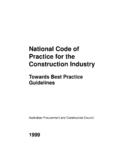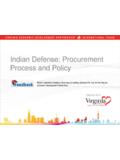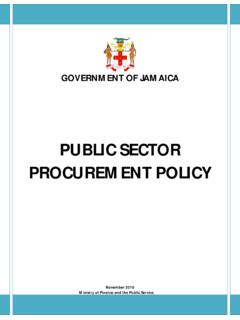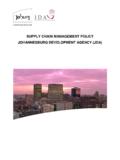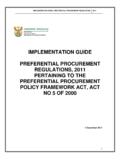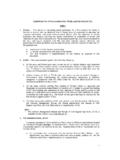Transcription of Australian Procurement and Construction Council Inc
1 Australian Procurement and Construction Council Inc PROFESSIONAL. INDEMNITY. INSURANCE guidelines . IN THE BUILDING AND Construction INDUSTRY. BUILDING. Construction . Australian Procurement and Construction Council Inc PROFESSIONAL INDEMNITY INSURANCE guidelines . IN THE BUILDING AND Construction INDUSTRY. Requests for additional copies of this document should be addressed to: Australian Procurement and Construction Council Inc. (APCC). PO Box 106. DEAKIN WEST ACT 2600. Unit 6, 42 Geils Court DEAKIN ACT 2600. Phone: 02 6285 2255. Fax: 02 6282 3787. Email: Web Site: ISBN 1 920751 06 8.
2 The work contained within this document is copyright. This document may not be in part or whole, reproduced without prior permission from the Australian Procurement and Construction Council . PROFESSIONAL. INDEMNITY. INSURANCE guidelines . INTRODUCTION. These guidelines have been prepared by the Australian Procurement and Construction Council (APCC) to assist Australian , State and Territory government agencies to determine the level of Professional Indemnity Insurance (PII) which may be appropriate to the services they require from consultants in the building and Construction industry.
3 The availability and affordability of Professional Indemnity Insurance to support project Procurement is no longer guaranteed given the condition of insurance markets around the world. Insurance therefore needs to be regarded as a limited resource. These guidelines are intended to assist Government clients (principals) to identify an appropriate level of insurance to be held by consultants (refer Sections 1 and 2). The Professional Indemnity Insurance guidelines Are intended to guide government agencies and public organisations involved in the Procurement of hospitals, schools, custodial facilities, design services, non- Construction , project management, etc, however this does not preclude them from being used in the private sector.
4 Relate to Professional Indemnity Insurance only and do not refer to other liability issues;. Recognise that for particular activities ( asbestos, toxic mould and terrorism). insurance may not be available and that Government clients may need to accept some of the risk; and Recognise that some special cases may require other arrangements. These guidelines only deal with Professional Indemnity Insurance and have not attempted to address some of the broader issues such as: Principal Controlled Professional Indemnity Insurance, Professional Standards Legislation and Limit of Liability.
5 The guidelines will be reviewed in twelve months. DISCLAIMER These guidelines are subject to the impact of the proposed Professional Standards Legislation to be enacted nationally and may require review in relation to any schemes administered there-under. 1. Professional Indemnity Insurance guidelines for the Building and Construction Industry 1. THE LEVEL OF COVER. Two approaches are presented to indicate the suggested level of cover: A Simplified Method; and A Risk Assessment Based Method The Simplified Method is considered appropriate for simple, non- Construction related consultation and all projects under $1million.
6 More complex projects due to the type of Construction , technology or environment in which they are constructed may warrant the use of the Risk Assessment Based Method. Simplified Method This method is considered appropriate for projects that agencies consider conventional non- Construction consultancies and for all conventional projects, (including all projects up to $1 million) undertaken in the civil engineering and building industries. It is suggested that the amount of Professional Indemnity Insurance (PI Insurance) per event and in the aggregate, to be provided for typical projects by the consultant to the principal should be the greater of $1 million or ten times the fee.
7 Risk Assessment Based Method This approach addresses particular risks associated with both the project type and the nature of the professional services being provided. The process suggested is as follows: Use the Project Risk Assessment to identify overall project risk (refer section ). Use the Professional Service Risk Assessment to identify service risk (refer section ). The methodology outlined in the Australian and New Zealand Standard AS/NZS 4360: 1999 Risk Management, provides guidance on these issues. Using Appendix E of AS4360 as a guide, a risk may be categorised in the following terms: extreme, high, moderate and low.
8 On complex or large projects, it is recommended that the risk assessment be carried out in accordance with the Australian and New Zealand Standard. 2. Professional Indemnity Insurance guidelines for the Building and Construction Industry 1. THE LEVEL OF COVER. Project Risk Projects need to be assessed to identify the overall project risk and may be thought of in the following terms. The risk descriptor may vary by project depending on the level of complexity and criticality to the project, acoustic design1. See Addendum A for a comprehensive list. Risk Descriptor Definition Examples Extreme (E) Immediate action required Repair of collapsed bridge, pollution clean up, contamination, asbestos removal, oil or gas fire High (H) Senior management Tunnels, marine works, mining, attention needed nuclear reactors, temporary structures, certain design services Moderate (M) Management responsibility Pipelines, regulatory codes &.
9 Must be specified requirements, road & rail infrastructure, bridges, demolition (M/H), project management, design hospitals Low (L) Managed by routine Non- Construction , conventional procedures structures, training manuals, interior & landscape design, planning studies In carrying out a risk identification and analysis in accordance with the AS/NZ 4360. Risk Management Standard to identify the risk inherent in a project, each risk may be considered and defined in terms of consequences. Each agency will have a different view on the nature of risk associated with projects. Some examples are as follows.
10 Extreme High Moderate Low Site Unstable Significant settlement Minor settlement Innocuous, stable Natural Threatened Very sensitive Managed Innocuous, Environment co-existence unmanaged Technology Experimental Innovative or new Innovative Routine application application Function Essential for life Essential with <12 hr 1 Week interruption Non essential Reliance >100,000 people 20,001 to 100,000 1,000 to 20,000 >1,000 people per day people per day people per day per day 1 Please note for building and Construction projects, terms are defined in Appendix E Table E3 in the AS/NZ 4360:1999.
